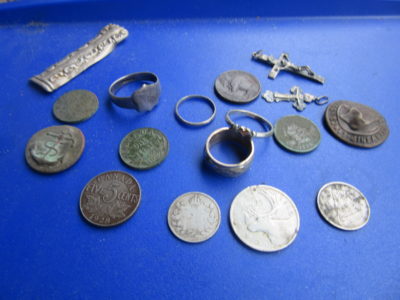19/ Developing Your Accuracy and Conclusiveness with the Anfibio Multi
Whenever I want to write some advanced material on any detector–I’m continually drawn back to basic skills and competencies. The material in this book on; audio signal types, target types, basic skills, coil control and basic detector theory are necessary precursors to the more important device-specific information. The idea is to learn to “walk first”–then think about running “99” Gain in dense iron. Let’s look at how some of these basic skills allow us to move away from the “hopeful digging” model that so many engage in–towards greater accuracy and conclusiveness.
20/ Meter, Tone and Gain
It follows from the above discussion of the ”Power Curve” that as we increase the Gain of a high Gain detector a number of things begin to happen. For one thing–meter responses become more varied. This has been well-termed “ID splatter” something that’s a concern with the Anfibio. At the same time–there’s a lot of information to be gotten from this “splatter.” This bears upon our basic target types. Where you have a clean, single metal or a good conductor such as gold–expect a narrower ID response. Where you have something that’s diversely alloyed–expect a wide array of ID numbers to show.
An important distinction in these meter responses is that where you have a less complex alloy–such as gold or silver–numbers that “climb” are more common. These “climbing” meter responses are signals that are consistent enough to give sequential or close numbers–ascending or dropping. Where you have something that the Anfibo is struggling to identify–you have what I call “cycling” digits–big jumps–that may include low digits–or even “wrap” range readings. It’s also important to recognize that along with your Gain setting, coil control is the mediator of these responses. A wide sweep brings in more data to be analyzed. A fast sweep acts to confuse the machine’s circuits–also making for more scattered readings. Understanding and using this ID characteristic will later become an important “weapon” for acquiring and getting conclusive identification of signals in dense iron–by reducing the ”ratio” of other influences around the signal. (While there will be those who would say that “there’s no such thing as a conclusive ID”–here the idea is to begin by just moving towards recognizing the “no brainers).”
An important tip from the Notka / Makro manuals is that to get the best target ID from the Anfibio–slow down the coil. This is especially true in dense iron in that you are giving the machine more time to process the complex set of information under the coil and give an accurate report. Where you still see “wild” indications–suspect something alloyed, corroded or misshapen.
It’s also worth noting that as we reduce the Gain setting, the above meter differences: “(climbing” versus “cycling” and the size of these meter changes), become more meaningful. So whereas a high Gain setting might produce “wild” meter readings on an odd-shaped gold earring–a lower setting might tame this down–drawing your attention to the signal. This is another casualty of a high Gain setting–accuracy. This is not to say that we need to stick to the low presets–but there’s a need for more careful attention to how the meter acts in concert with your Gain.
From: “Successful Treasure Hunting with the Nokta / MakroAnfibio Multi.”
For more information on my book and to read a few reviews go to:
clivesgoldpage.com
…or click on “Products” above.

A few of the author’s finds from an old site with the Nokta Makro Anfibio